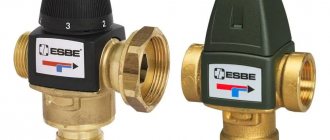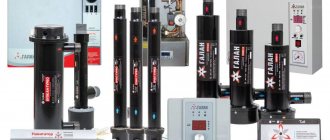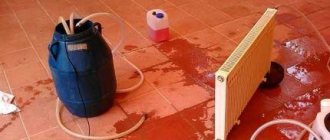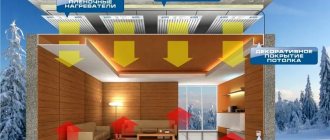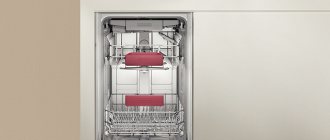For heating private homes and preparing hot water, double-circuit gas boilers are ideal. They work on the basis of transferring to the coolant the energy generated during the combustion of the most affordable and popular type of fuel. However, due to the extensive range of equipment, it can be difficult to choose. Do you agree?
We will tell you how to decide on the most suitable gas boiler model. The article we have proposed provides all the guidelines for choosing a unit with the highest possible efficiency that can withstand intense operating load. Market leading models and trusted manufacturers are listed.
Design features of the unit
A household gas appliance consists of a housing, two communication circuits, a built-in burner, a heat exchanger, an expansion tank, a combustion product exhaust unit, a gas valve and a control unit.
The main circuit is connected to the common heating system in a closed circuit. When the unit is actively operating in heating mode, the coolant circulates through the primary circuit pipes, but does not enter the hot water supply (DHW) communication system, since the path there is blocked by a special valve.
When installing equipment with two circuit elements, you must remember that the length of the communication pipe connecting the boiler to the farthest point of water intake should not exceed 7 meters. Otherwise, mineral elements deposited in the form of scale in the heat exchanger area will begin to interfere with the movement of the working fluid and the productivity of the water heater will significantly decrease
When the user turns on a hot tap in the kitchen or bathroom, the valve is activated, closes the entrance to the heating pipes and directs the coolant to the DHW circuit to warm up the water in the heat exchanger.
From there, the liquid enters the tap and is used for its intended purpose. When there is no longer a need for hot water and the tap is closed, a reverse switch occurs and the valve again redirects the coolant to the heating circuit.
How to make the right choice?
Above, we provided detailed information about what boilers with separate or bithermic heat exchangers are, talked about the principle of their operation, and listed their advantages and disadvantages.
When choosing a boiler model, you should take into account your goals and operating conditions. You need to understand that no matter what choice you make, you will have to compromise with some disadvantages and get used to the maintenance features of a particular model.
A bithermic heat exchanger is cheaper, and this fact attracts many buyers. If you use a high-quality coolant without a large amount of impurities, then servicing the boiler will be inexpensive, since its design is much simpler than that of boilers with two separate heat exchangers.
When choosing a boiler with a bithermal heat exchanger, it is easier to choose a reliable model, while equipment with separate heat exchangers requires a closer study of all the characteristics and design features.
Classification by installation location
According to the installation principle, boilers serving two communication circuits are floor-mounted, wall-mounted and parapet-mounted. Each option has its own special characteristics.
Based on them, the client can choose the most suitable installation method for himself, in which the equipment will be conveniently located, will not “eat up” the usable area and will not cause problems during operation.
Floor-standing boilers
Floor-standing units are high-power devices that can heat and provide hot water not only to a standard apartment or residential building, but also to a large industrial premises, public building or structure.
If a double-circuit boiler is planned to be used not only for heating and supplying domestic hot water, but also for replenishing warm water floors, the basic unit is equipped with an additional circuit
Due to their large size and significant weight (up to 100 kg for some models), floor-standing gas boilers are not installed in the kitchen, but are placed in a separate room directly on the foundation or on the floor.
Features of wall equipment
A mounted appliance is a progressive type of household heating equipment. Due to its compact size, a geyser can be installed in the kitchen or other small rooms. It can be combined with any type of interior solution and fits organically into the overall design.
A double-circuit wall-hung boiler can be placed not only in the kitchen, but also in the pantry. It will take up minimal space and will not interfere with furniture or other household appliances
Despite its small size, a wall-mounted boiler has the same functionality as a floor-standing device, but has less power. It consists of a burner, an expansion tank, a pump for forced movement of the coolant, a pressure gauge and automatic sensors that make it possible to use the fuel resource with maximum efficiency.
All communication elements are “hidden” under a beautiful, modern case and do not spoil the appearance of the product.
The flow of gas to the burner is controlled by a built-in safety system. In the event of an unexpected interruption of the resource supply, the unit’s functioning completely stops. When fuel starts flowing again, the automation automatically activates the equipment and the boiler continues to operate in standard mode.
The automatic control unit allows you to set the device any operating parameters that are most suitable for the user. It is possible to set your own temperature conditions for different times of the day, thus ensuring economical consumption of fuel resources.
Nuances of parapet devices
A parapet boiler is a cross between a floor-mounted and a wall-mounted unit. It has a closed combustion chamber and does not create harmful emissions. Does not require the installation of an additional chimney. The combustion products are removed through a coaxial chimney laid in the outer wall.
A parapet-type boiler is the best option for heating equipment for small rooms with a weak ventilation system. The device is designed so that during operation it does not emit combustion products into the atmosphere of the room in which it is installed.
The device is mainly used to provide hot water and full heating to small houses and apartments in high-rise buildings where it is not possible to install a classic vertical chimney. The basic power ranges from 7 to 15 kW, but despite such low figures, the unit successfully copes with the assigned tasks.
The main advantage of parapet equipment is the ability to connect heating and water supply communications to the central gas system and pipelines from any side convenient for the user.
Minimum characteristics of double-circuit boilers
When choosing a boiler for your home, you need to consider the following parameters:
- Power. Shows how much heat is being produced.
- Efficiency Efficiency of using heat from the flame. Characterizes how economical the boiler is.
- Temperature of the gases released.
- Where heat is conducted. Water or antifreeze.
- Maximum pressure for work.
- Outlet temperature maximum
- Hot water capacity. How much water heats up in one minute. Depends on the desired water temperature.
- Maximum amount of gas required.
- Gas supply. Characterizes stability of operation during sudden jumps.
- Features of electricity consumption: voltage and frequency.
- The power that is expended.
- Dimensions, including weight, fastening features and gas exhaust dimensions. These features do not indicate whether the boiler is good or bad. They must correspond to the purposes of operation. For example, boilers with different capacities are suitable for heating rooms of different sizes.
But in reality, you will get tired of paying attention to all these characteristics. Just remember that wall-mounted boilers are basically all the same in these characteristics. They differ simply in small details. With floor-mounted ones, of course, more attention is required.
Model differences in power
Double-circuit boilers are divided by power into single-stage and two-stage. Single-stage devices always operate at a constant power level and use the same amount of fuel resource year-round.
This is not effective and entails excessive gas consumption, because a house or apartment requires high-quality heating for no more than 5 months a year. At all other times, running the equipment at full power is neither reasonable nor economically profitable.
When installing equipment with a base power of 30 kW, you should know that these types of devices should not be located in residential premises, but in separate rooms equipped with a high-quality ventilation system, individual access to the street and a full-fledged chimney
The functionality of two-stage devices is wider.
With it you can:
- regulate the gas flow regime and rationally consume fuel;
- reduce the number of on/off switches, thus reducing equipment wear and extending its service life;
- reduce the volume of harmful emissions into the air to a minimum.
Additionally, the device is equipped with a smooth switching module, which reduces energy consumption and allows you to simultaneously operate a boiler and a boiler of any capacity, installed separately.
Safety precautions during work
Observe the following rules:
- In a room with a gas boiler, install a gas analyzer connected to the solenoid valve on the fuel supply line.
- To avoid sparks, ground the metal parts of the unit.
- Supply gas through the dielectric insert.
- Do not store flammable materials in the same room as heaters.
- Regularly clean the chimney of a solid fuel boiler from soot.
When installing the boiler, follow the safety rules.
If you smell gas, do the following:
- close the valve on the fuel supply line;
- open doors and windows to ventilate the room;
- call a specialist.
Types of working gas burners
A gas burner can be atmospheric or pressurized. The first type has a simple design and does not produce any noise during operation. The module is cheap and, as a rule, is included in the basic package of the boiler.
Despite its simplicity, the atmospheric burner is very reliable and works well for a long time. Can be used both on budget devices and on expensive, “sophisticated” luxury products
The operating principle of an atmospheric burner is reminiscent of the operation of industrial hearth models. The fuel resource is supplied through an ejector and, due to draft, absorbs air from the surrounding atmosphere. Through a special hole, the mixture enters the combustion chamber and immediately ignites.
As a result, fiery tongues of flame with a very low actual temperature appear above the outlet holes, the task of which is to heat the coolant to the required level.
Pressurized (mounted) burners demonstrate a high level of efficiency, constantly maintaining the set temperature both in the coolant itself and in the hot water supply system, but they are much more expensive than their atmospheric counterparts.
However, these costs are justified, since the modules have expanded functionality and make it possible to use fuel resources as wisely as possible, without reducing the level of comfort of the home.
A pressurized (mounted) type burner is not included in the basic set of a double-circuit gas boiler. It is purchased separately and then installed on heating equipment
During full operation in pressurized burners, the air supply is forced, and its volume is very clearly controlled by internal automation. The module is installed in devices equipped with a closed combustion chamber operating with supercharging.
Fuel and air are mixed not inside the system, but at the outlet. The operating process of the device is almost completely automated and does not require human control.
Atmospheric burners are installed in dual-circuit heating devices with a power of up to 80 kW. Supercharged (mounted) modules are being implemented into large-sized units with a capacity of up to several thousand.
Types of ignition function
A household double-circuit boiler is started manually (using matches or a lighter) or using built-in elements (electric ignition or piezo ignition). The first method is the simplest and most accessible. The second makes it possible to save blue fuel by not leaving the wick in the igniter to burn constantly.
There is only one disadvantage of this option - dependence on the availability of electricity in the network. If for some reason the power stops flowing, the equipment immediately turns off and is automatically activated again when the electrical supply is restored.
Piezo ignition is absolutely safe and allows you to turn on the boiler by pressing just one button. The element does not depend on the supply of current and you can use the equipment even in the absence of electricity.
Equipment traction options
During operation of the unit, fuel burns and flue gases are generated. To remove them from a living space, natural or forced draft is necessary. It will ensure timely removal of all combustion products and released harmful substances from the apartment or house.
Natural draft modules
Boilers operating on natural draft have a simple design and take the air necessary for proper combustion from the room in which they are located. During intensive use, a certain amount of steam and various chemicals are released. Emissions are removed through a vertical chimney.
Among the main advantages of units with natural draft are reasonable cost, energy independence and absence of noise effects during operation.
In general, devices with natural draft are convenient and good, however, when the pressure in the gas pipeline drops, the quality of their work decreases significantly. At the same time, the risk of rapid burnout of the burner increases, since the fire at a reduced pressure level dies out or goes inside the burner device.
Uneven pressure in the main networks provokes serious overconsumption of fuel, which entails an increase in the amount of utility bills.
Forced draft devices
Boilers with forced draft are sometimes called forced-air or fan-type. They take air not from the room where they are located, but from the street. The modules have closed combustion chambers, and waste substances are emitted through a coaxial horizontal outlet using a powerful fan built into the system.
A coaxial bend consists of two pipe elements of different diameters inserted into one another. Through the smaller pipe, combustion products exit the room, and through the space between the small and large pipes, fresh air enters the room from the street, which is necessary for the full functioning of the boiler
Products with forced draft are easy to install, do not make any demands on the location, do not “eat up” oxygen in residential premises, work stably and accurately even with reduced gas pressure in the central main networks and do not require the installation of an additional vertical chimney.
The devices are criticized for the noisy operation of fan elements, higher cost and dependence on power supply.
In what case should you definitely abandon a boiler with bithermal heat exchangers?
If you have very bad water in your house, highly saturated with salts, refrain from this type of equipment, otherwise after 2-3 heating seasons you will have to change the heat exchanger, and this is very expensive.
Alternatively, you can use cleaning systems, as we mentioned above. But don’t think that if you have separate heat exchangers, then you don’t need to worry about water quality.
Any type of heat exchanger will clog sooner or later, but in most cases, servicing a boiler with a bithermic heat exchanger will cost the most.
Distinctive features of heat exchangers
The heat exchange unit of the heating device can be cast iron, steel or copper. The cast iron version retains heat for a long time, is almost not subject to corrosion due to the high wall thickness and is resistant to aggressive coolants. It is heavy and therefore mainly integrated into floor-standing boilers.
Requires great care during installation, since any impacts violate the structural integrity of the material and lead to the formation of microcracks.
The steel structure weighs little, is not afraid of mechanical stress, can easily withstand temperature changes in the coolant, and is easily transported and installed. Has some tendency to corrosion. The boiler control system helps to avoid it, which prevents the coolant temperature from falling below the critical point.
Copper elements are an order of magnitude more expensive than their cast iron and steel counterparts, but they compensate for the substantial cost with a large number of advantages. Inside the copper heat exchanger, sediment and scale are formed to a minimum and do not interfere with the normal circulation of the working fluid. The walls of the device are heated evenly and do not cause local overheating of the coolant.
Advantages and disadvantages of gas systems
In places where central gas communications are laid, double-circuit boilers are very popular. They are purchased for heating and uninterrupted supply of hot water to apartments, residential buildings and country cottages.
The main advantages of the devices
The gas system demonstrates a high level of efficiency, delivers several times more energy than it consumes, lasts a long time and operates smoothly. Does not require constant human supervision.
The double-circuit boiler looks neat and modern. Unlike units operating on solid or liquid fuels, during operation it practically does not emit unpleasant odors and creates a minimum of soot and soot
The fuel resource is supplied to the installation continuously, and the built-in controller independently monitors the presence of fire on the burner. If the flame dies out, the sensor sends a signal to the ignition unit and the automatic supply of a spark instantly restores the fire. Controlling the boiler is simple and does not present any difficulty.
Disadvantages of dual-circuit equipment
The main disadvantages are associated not so much with the device itself, but with the process of its legalization and installation. You can’t just buy a boiler, bring it home and install it yourself according to the connection diagram. First, you will have to comply with a lot of technical nuances, draw up documentation and coordinate all subsequent actions with the local gas supply company.
There you will need to provide:
- equipment installation project, drawn up in accordance with the norms adopted by law;
- installation agreement with a specialized organization;
- a copy of the license of the specialized organization confirming the right to carry out work.
In addition, you will need to organize the removal of exhaust gas from the living space, lay an additional chimney for this or use an existing old one, and install additional equipment to control potential gas leaks.
If the boiler smokes, perhaps the pressure in the system has decreased or the existing burner has worn out and begun to burn out. A specialist with relevant experience will help you quickly fix problems
The main installation activities can begin only when the project documentation for the organization of gas heating has passed all stages of approval and the client receives a stamped permit for the installation of the system.
Review of popular manufacturers and models
The market for modern gas equipment offers customers a large number of high-quality appliances designed for heating residential premises and supplying hot water.
Among the mounted units, the most popular are:
- Navien DELUXE 24K (South Korea) - efficiency, good functionality and reasonable cost;
- Baxi MAIN 5 24 F (Italy) – budget price, high level of efficiency, long service life;
- Vaillant turboTEC pro VUW 242/5-3 (Germany) – reliability, high-quality heat transfer.
In addition to the above qualities, the models are distinguished by their attractive appearance, compact dimensions, fit into a variety of interiors and can be easily placed even in small rooms with complex layouts.
A gas appliance with two circuits from the German company Vaillant has a convenient control knob and a display on which you can see the level of heating of the coolant at the moment
Of the floor-standing units, the most popular are the high-power (30 kW) ATON Atmo 30E, the practical Lemax Premium-25B and the more expensive, but very functional Navien GA 17KN.
Navien GA 35KN, despite its high power, uses fuel reasonably and allows owners to save on utility bills without compromising personal comfort
Baxi SLIM 2.300 Fi and Protherm Bear 40 KLZ are part of the premium line of equipment. They have advanced functionality and reliably serve for many years. In all parameters and physical characteristics they comply with the most stringent European standards (confirmed by certification certificate CSQ and UNI EN ISO 9001).
For a small room (up to 50 sq.m.), a boiler with a base power of 7 to 12 kW is suitable. If the real estate area is larger (for example, 150-200 sq.m.), it is better to purchase a 23-25 kilowatt device
Weak units simply cannot provide full heating to an apartment or large house.
You should buy floor-standing gas boilers and wall-mounted models only in branded stores or official representative offices of manufacturing companies. There, the client will be told in detail about the operating principles of this or that unit and will be helped to make the optimal choice.
Where can I buy
Having figured out the design of a double-circuit wall-mounted gas boiler, you should think about purchasing it. Additionally, you will need a chimney kit.
Among those that have proven themselves in this market, one can note one of the largest manufacturers of chimneys in Russia - Industrial. Thanks to the latest metalworking tools and a careful approach to the selection of raw materials, it produces only high-quality products.
The undeniable advantages of FERRUM chimneys:
- They are not inferior in quality to European analogues, but cost 2 times less.
- Suitable for any heating devices.
- They are easy to install.
- Manufactured from stainless, heat-resistant steel.
- Average service life is 20 years.
You can get all the necessary information and find out prices for chimneys by calling the phone number listed on the official website of PC Ferrum.

